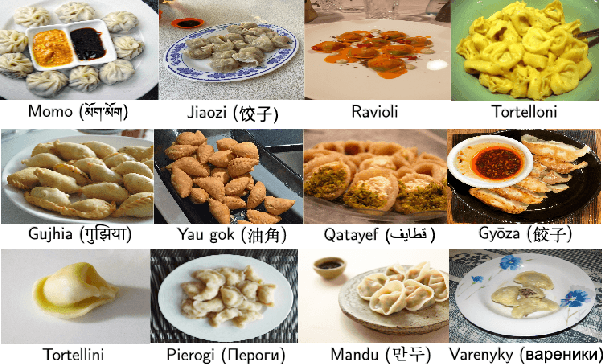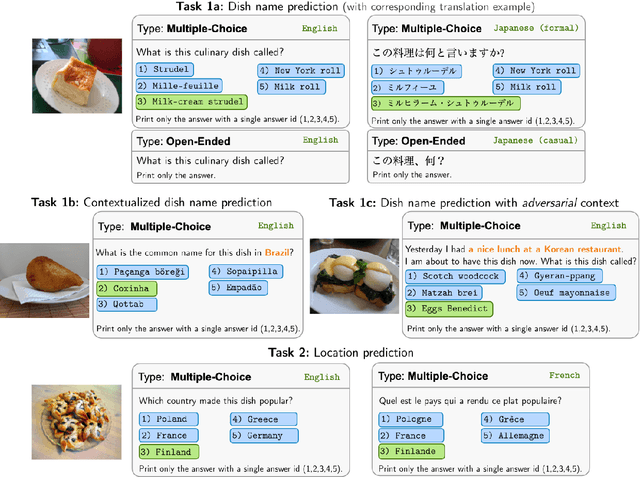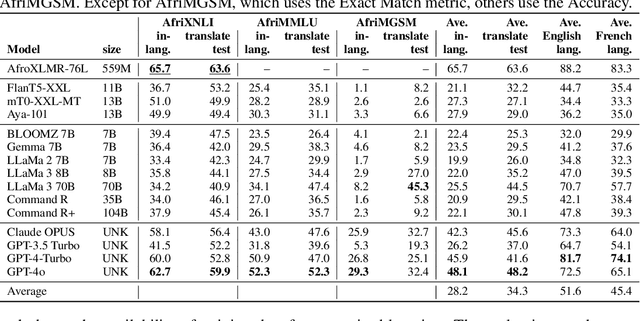En-Shiun Annie Lee
Beyond Vanilla Fine-Tuning: Leveraging Multistage, Multilingual, and Domain-Specific Methods for Low-Resource Machine Translation
Mar 28, 2025Abstract:Fine-tuning multilingual sequence-to-sequence large language models (msLLMs) has shown promise in developing neural machine translation (NMT) systems for low-resource languages (LRLs). However, conventional single-stage fine-tuning methods struggle in extremely low-resource NMT settings, where training data is very limited. This paper contributes to artificial intelligence by proposing two approaches for adapting msLLMs in these challenging scenarios: (1) continual pre-training (CPT), where the msLLM is further trained with domain-specific monolingual data to compensate for the under-representation of LRLs, and (2) intermediate task transfer learning (ITTL), a method that fine-tunes the msLLM with both in-domain and out-of-domain parallel data to enhance its translation capabilities across various domains and tasks. As an application in engineering, these methods are implemented in NMT systems for Sinhala, Tamil, and English (six language pairs) in domain-specific, extremely low-resource settings (datasets containing fewer than 100,000 samples). Our experiments reveal that these approaches enhance translation performance by an average of +1.47 bilingual evaluation understudy (BLEU) score compared to the standard single-stage fine-tuning baseline across all translation directions. Additionally, a multi-model ensemble further improves performance by an additional BLEU score.
AlignFreeze: Navigating the Impact of Realignment on the Layers of Multilingual Models Across Diverse Languages
Feb 18, 2025Abstract:Realignment techniques are often employed to enhance cross-lingual transfer in multilingual language models, still, they can sometimes degrade performance in languages that differ significantly from the fine-tuned source language. This paper introduces AlignFreeze, a method that freezes either the layers' lower half or upper half during realignment. Through controlled experiments on 4 tasks, 3 models, and in 35 languages, we find that realignment affects all the layers but can be the most detrimental to the lower ones. Freezing the lower layers can prevent performance degradation. Particularly, AlignFreeze improves Part-of-Speech (PoS) tagging performances in languages where full realignment fails: with XLM-R, it provides improvements of more than one standard deviation in accuracy in seven more languages than full realignment.
WorldCuisines: A Massive-Scale Benchmark for Multilingual and Multicultural Visual Question Answering on Global Cuisines
Oct 16, 2024



Abstract:Vision Language Models (VLMs) often struggle with culture-specific knowledge, particularly in languages other than English and in underrepresented cultural contexts. To evaluate their understanding of such knowledge, we introduce WorldCuisines, a massive-scale benchmark for multilingual and multicultural, visually grounded language understanding. This benchmark includes a visual question answering (VQA) dataset with text-image pairs across 30 languages and dialects, spanning 9 language families and featuring over 1 million data points, making it the largest multicultural VQA benchmark to date. It includes tasks for identifying dish names and their origins. We provide evaluation datasets in two sizes (12k and 60k instances) alongside a training dataset (1 million instances). Our findings show that while VLMs perform better with correct location context, they struggle with adversarial contexts and predicting specific regional cuisines and languages. To support future research, we release a knowledge base with annotated food entries and images along with the VQA data.
URIEL+: Enhancing Linguistic Inclusion and Usability in a Typological and Multilingual Knowledge Base
Sep 27, 2024



Abstract:URIEL is a knowledge base offering geographical, phylogenetic, and typological vector representations for 7970 languages. It includes distance measures between these vectors for 4005 languages, which are accessible via the lang2vec tool. Despite being frequently cited, URIEL is limited in terms of linguistic inclusion and overall usability. To tackle these challenges, we introduce URIEL+, an enhanced version of URIEL and lang2vec addressing these limitations. In addition to expanding typological feature coverage for 2898 languages, URIEL+ improves user experience with robust, customizable distance calculations to better suit the needs of the users. These upgrades also offer competitive performance on downstream tasks and provide distances that better align with linguistic distance studies.
ProxyLM: Predicting Language Model Performance on Multilingual Tasks via Proxy Models
Jun 14, 2024



Abstract:Performance prediction is a method to estimate the performance of Language Models (LMs) on various Natural Language Processing (NLP) tasks, mitigating computational costs associated with model capacity and data for fine-tuning. Our paper introduces ProxyLM, a scalable framework for predicting LM performance using proxy models in multilingual tasks. These proxy models act as surrogates, approximating the performance of the LM of interest. By leveraging proxy models, ProxyLM significantly reduces computational overhead on task evaluations, achieving up to a 37.08x speedup compared to traditional methods, even with our smallest proxy models. Additionally, our methodology showcases adaptability to previously unseen languages in pre-trained LMs, outperforming the state-of-the-art performance by 1.89x as measured by root-mean-square error (RMSE). This framework streamlines model selection, enabling efficient deployment and iterative LM enhancements without extensive computational resources.
IrokoBench: A New Benchmark for African Languages in the Age of Large Language Models
Jun 05, 2024



Abstract:Despite the widespread adoption of Large language models (LLMs), their remarkable capabilities remain limited to a few high-resource languages. Additionally, many low-resource languages (e.g. African languages) are often evaluated only on basic text classification tasks due to the lack of appropriate or comprehensive benchmarks outside of high-resource languages. In this paper, we introduce IrokoBench -- a human-translated benchmark dataset for 16 typologically-diverse low-resource African languages covering three tasks: natural language inference~(AfriXNLI), mathematical reasoning~(AfriMGSM), and multi-choice knowledge-based QA~(AfriMMLU). We use IrokoBench to evaluate zero-shot, few-shot, and translate-test settings~(where test sets are translated into English) across 10 open and four proprietary LLMs. Our evaluation reveals a significant performance gap between high-resource languages~(such as English and French) and low-resource African languages. We observe a significant performance gap between open and proprietary models, with the highest performing open model, Aya-101 only at 58\% of the best-performing proprietary model GPT-4o performance. Machine translating the test set to English before evaluation helped to close the gap for larger models that are English-centric, like LLaMa 3 70B. These findings suggest that more efforts are needed to develop and adapt LLMs for African languages.
A Reproducibility Study on Quantifying Language Similarity: The Impact of Missing Values in the URIEL Knowledge Base
May 17, 2024



Abstract:In the pursuit of supporting more languages around the world, tools that characterize properties of languages play a key role in expanding the existing multilingual NLP research. In this study, we focus on a widely used typological knowledge base, URIEL, which aggregates linguistic information into numeric vectors. Specifically, we delve into the soundness and reproducibility of the approach taken by URIEL in quantifying language similarity. Our analysis reveals URIEL's ambiguity in calculating language distances and in handling missing values. Moreover, we find that URIEL does not provide any information about typological features for 31\% of the languages it represents, undermining the reliabilility of the database, particularly on low-resource languages. Our literature review suggests URIEL and lang2vec are used in papers on diverse NLP tasks, which motivates us to rigorously verify the database as the effectiveness of these works depends on the reliability of the information the tool provides.
Unlocking Parameter-Efficient Fine-Tuning for Low-Resource Language Translation
Apr 05, 2024Abstract:Parameter-efficient fine-tuning (PEFT) methods are increasingly vital in adapting large-scale pre-trained language models for diverse tasks, offering a balance between adaptability and computational efficiency. They are important in Low-Resource Language (LRL) Neural Machine Translation (NMT) to enhance translation accuracy with minimal resources. However, their practical effectiveness varies significantly across different languages. We conducted comprehensive empirical experiments with varying LRL domains and sizes to evaluate the performance of 8 PEFT methods with in total of 15 architectures using the SacreBLEU score. We showed that 6 PEFT architectures outperform the baseline for both in-domain and out-domain tests and the Houlsby+Inversion adapter has the best performance overall, proving the effectiveness of PEFT methods.
Enhancing Hokkien Dual Translation by Exploring and Standardizing of Four Writing Systems
Mar 18, 2024Abstract:Machine translation focuses mainly on high-resource languages (HRLs), while low-resource languages (LRLs) like Taiwanese Hokkien are relatively under-explored. This study aims to address this gap by developing a dual translation model between Taiwanese Hokkien and both Traditional Mandarin Chinese and English. We employ a pre-trained LLaMA2-7B model specialized in Traditional Mandarin Chinese to leverage the orthographic similarities between Taiwanese Hokkien Han and Traditional Mandarin Chinese. Our comprehensive experiments involve translation tasks across various writing systems of Taiwanese Hokkien and between Taiwanese Hokkien and other HRLs. We find that the use of a limited monolingual corpus also further improve the model's Taiwanese Hokkien capabilities. We then utilize our translation model to standardize all Taiwanese Hokkien writing systems into Hokkien Han, resulting in further performance improvements. Additionally, we introduce an evaluation method incorporating back-translation and GPT-4 to ensure reliable translation quality assessment even for LRLs. The study contributes to narrowing the resource gap for Taiwanese Hokkien and empirically investigates the advantages and limitations of pre-training and fine-tuning based on LLaMA 2.
Predicting Machine Translation Performance on Low-Resource Languages: The Role of Domain Similarity
Feb 04, 2024Abstract:Fine-tuning and testing a multilingual large language model is expensive and challenging for low-resource languages (LRLs). While previous studies have predicted the performance of natural language processing (NLP) tasks using machine learning methods, they primarily focus on high-resource languages, overlooking LRLs and shifts across domains. Focusing on LRLs, we investigate three factors: the size of the fine-tuning corpus, the domain similarity between fine-tuning and testing corpora, and the language similarity between source and target languages. We employ classical regression models to assess how these factors impact the model's performance. Our results indicate that domain similarity has the most critical impact on predicting the performance of Machine Translation models.
 Add to Chrome
Add to Chrome Add to Firefox
Add to Firefox Add to Edge
Add to Edge